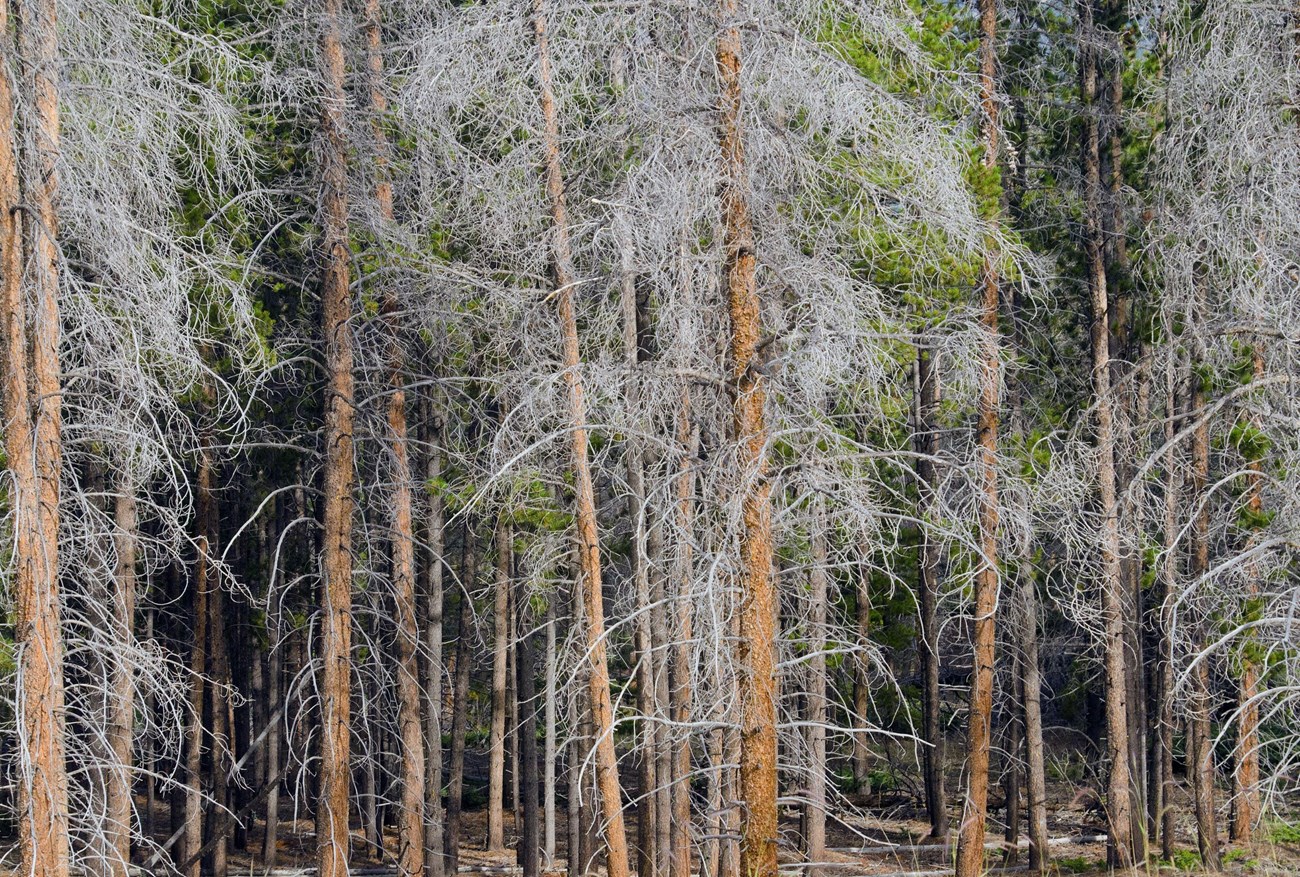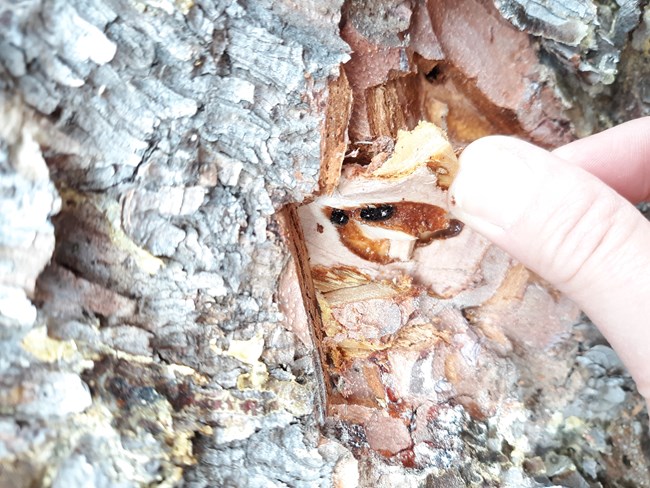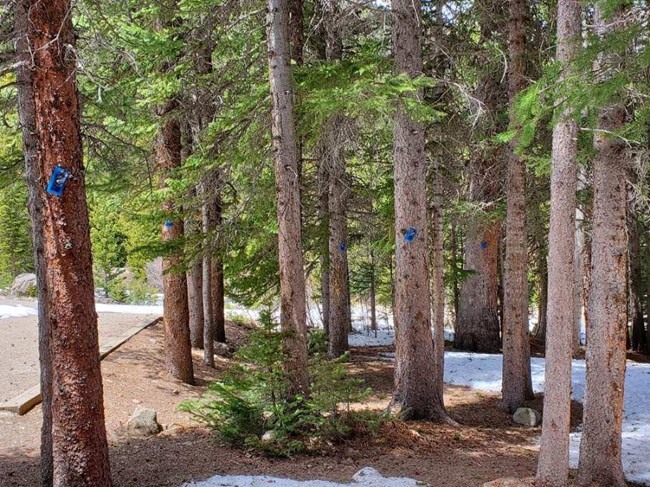Last updated: August 27, 2020
Article
Semiochemicals: A Path Forward for Forest Protection from the Spruce Bark Beetle

NPS/W Kaesler

Photo courtesy of S Stephens, USFS.
The spruce beetle is native to North America. Females tunnel into spruce trees to lay eggs, and the hatched larvae continue to burrow within the inner bark. The following summer, adults emerge to find new trees to lay the next generation of eggs and continue to cycle. But warmer temperatures can increase overwinter survival of beetles, and drier conditions can make spruce trees more vulnerable to spruce beetle attacks. Since the 1990s, a trend in these warmer and drier conditions has led to extensive and ongoing spruce beetle outbreaks in western North America.
Semiochemicals are pheromones and other chemicals given off by one organism that signal others to modify their behavior. In finding suitable habitat, female spruce beetles will release pheromones to attract mates; males on the other hand will release another pheromone, MCH, as a way to detract other spruce beetles. MCH isn’t the only chemical signature that can ‘tell’ beetles that an area is no longer suitable or available. Trees also give off odors that can ‘announce’ the general health of a tree or forest stand.
The Project:
Recognizing that multiple chemical indicators are at play, scientists tested the effectiveness of a variety of semiochemicals at repelling spruce beetles. From 2013 to 2017, traps containing different types and combinations of semiochemicals were set out in infected forested areas in Utah and Colorado (including Rocky Mountain National Park's Hidden Valley in 2017) during June and July - the adult spruce beetle’s flight season. Captured insects were then collected, counted, and identified to species. Based on these results, the most promising semiochemical repellents were then used in individual tree and area protection treatment studies.
Recognizing that multiple chemical indicators are at play, scientists tested the effectiveness of a variety of semiochemicals at repelling spruce beetles. From 2013 to 2017, traps containing different types and combinations of semiochemicals were set out in infected forested areas in Utah and Colorado (including Rocky Mountain National Park's Hidden Valley in 2017) during June and July - the adult spruce beetle’s flight season. Captured insects were then collected, counted, and identified to species. Based on these results, the most promising semiochemical repellents were then used in individual tree and area protection treatment studies.

Photo courtesy of S Stephens, USFS
The Results:
While a variety of semiochemicals were tested as part of the trapping bioassay component of this study, most did not significantly reduce the amount of spruce beetles attracted to the trees. Fortunately, however, there was a few semiochemicals and semiochemical combinations that did show strong repellency. AKB reduced beetle captures in the traps by over 80% when compared to traps that only contained bait. The trap study also found that higher overall concentrations of MCH had a positive effect in deterring beetles. AKB is made up of three main components. Traps that contained only one component were less successful overall, and in some cases success varied by location. When all three components of AKB were included, the traps were maximally successful in deterring beetles. Because of this, AKB was used in the individual tree and area protections studies.
When individual tree protection was measured in 2017, control trees (trees with bait only) were over 73 times more likely to be severely attacked by spruce beetles. Trees within 10 meters of a tree with repellent also had an advantage. 2018 data specific to the Rocky Mountains, found MCH-AKB treatments to be successful, but did not see any real difference between the treatment types (MCH-AKB, MCH-AKB with sulcatone, and higher concentrations of MCH-AKB). When area protection was examined, spruce in the control plots (plots without repellent) were 2.4 times more likely to be severely attacked by spruce beetles.
Overall, this study found that, at least in the southern Rocky Mountains, MCH-AKB provided significant protection to individual trees. Researchers on this study were greatly encouraged by these results and the potential use of semiochemicals, AKB in particular, as a large-scale spruce beetle management tool. Several years of on the ground observations by researchers on this project also attest to the success of MCH-AKB in combination. This method could reduce the use of insecticides which also pose environmental and health risks. Also, semiochemicals are relatively inexpensive. AKB still needs to go through registration and labelling protocols before it can be widely available, but this new tool for the forestry toolbox may be just the thing forest managers are looking for.
Reference article: Hansen, E.M.; A.S. Munson; D. Wakarchuk, D.C. Blackford; A.D. Graves; S.S. Stephens; and J.E. Moan. 2019. Advances in Semiochemical Repellents to Mitigate Host Mortality from the Spruce Beetle (Coleoptera: Curculionidae). Journal of Economic Entomology 112(5):2253-2261. https://doi.org/10.1093/jee/toz172
While a variety of semiochemicals were tested as part of the trapping bioassay component of this study, most did not significantly reduce the amount of spruce beetles attracted to the trees. Fortunately, however, there was a few semiochemicals and semiochemical combinations that did show strong repellency. AKB reduced beetle captures in the traps by over 80% when compared to traps that only contained bait. The trap study also found that higher overall concentrations of MCH had a positive effect in deterring beetles. AKB is made up of three main components. Traps that contained only one component were less successful overall, and in some cases success varied by location. When all three components of AKB were included, the traps were maximally successful in deterring beetles. Because of this, AKB was used in the individual tree and area protections studies.
When individual tree protection was measured in 2017, control trees (trees with bait only) were over 73 times more likely to be severely attacked by spruce beetles. Trees within 10 meters of a tree with repellent also had an advantage. 2018 data specific to the Rocky Mountains, found MCH-AKB treatments to be successful, but did not see any real difference between the treatment types (MCH-AKB, MCH-AKB with sulcatone, and higher concentrations of MCH-AKB). When area protection was examined, spruce in the control plots (plots without repellent) were 2.4 times more likely to be severely attacked by spruce beetles.
Overall, this study found that, at least in the southern Rocky Mountains, MCH-AKB provided significant protection to individual trees. Researchers on this study were greatly encouraged by these results and the potential use of semiochemicals, AKB in particular, as a large-scale spruce beetle management tool. Several years of on the ground observations by researchers on this project also attest to the success of MCH-AKB in combination. This method could reduce the use of insecticides which also pose environmental and health risks. Also, semiochemicals are relatively inexpensive. AKB still needs to go through registration and labelling protocols before it can be widely available, but this new tool for the forestry toolbox may be just the thing forest managers are looking for.
Reference article: Hansen, E.M.; A.S. Munson; D. Wakarchuk, D.C. Blackford; A.D. Graves; S.S. Stephens; and J.E. Moan. 2019. Advances in Semiochemical Repellents to Mitigate Host Mortality from the Spruce Beetle (Coleoptera: Curculionidae). Journal of Economic Entomology 112(5):2253-2261. https://doi.org/10.1093/jee/toz172
Written by Carissa Turner
Continental Divide Research Learning Center, Rocky Mountain National Park
Continental Divide Research Learning Center, Rocky Mountain National Park
